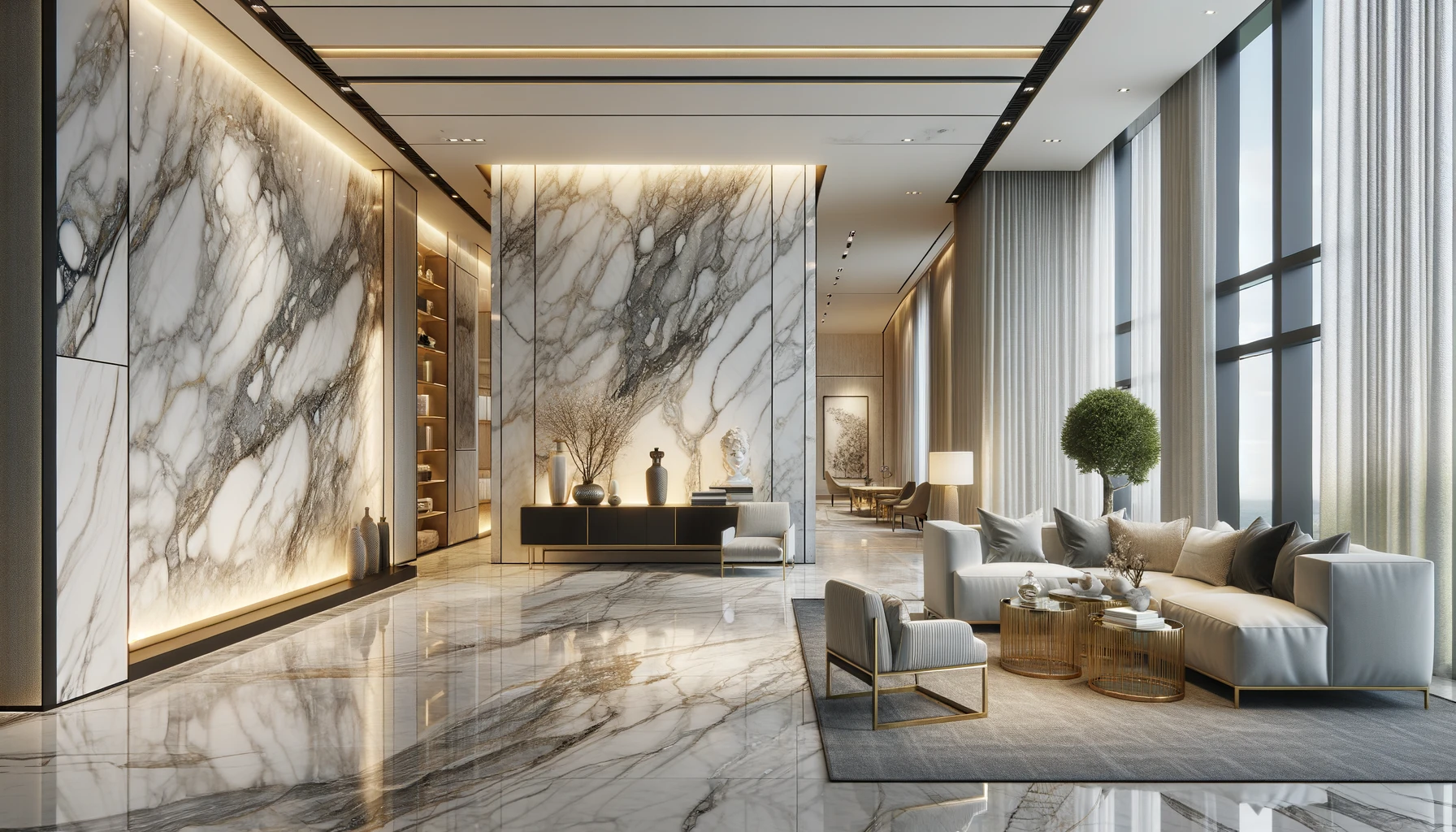Introduction to Calacatta Marble
Calacatta marble, an epitome of luxury and sophistication, stands out in the world of natural stones. With its distinctive veining and pure white backdrop, it has been the choice of royalty, designers, and homeowners for centuries. Hailing from the Carrara region in Italy, Calacatta’s allure is not limited to its breathtaking appearance. The rich history behind its extraction and its cultural significance further elevates its stature in the world of interior design and architecture.
Types of Calacatta Marble
The world of Calacatta is vast and diverse. Each type comes with its unique charm and color spectrum, catering to different tastes and design philosophies:
- Calacatta Oro: A variant that oozes opulence, Calacatta Oro is known for its golden veining, making it a favorite for those seeking a royal touch.
- Calacatta Viola: The mesmerizing streaks of violet set this variant apart. Perfect for spaces that need a pop of color and vibrancy.
- Calacatta Borghini: For lovers of drama and intensity, Calacatta Borghini’s pronounced veining makes it the go-to choice.
Applications in Interior Design
Calacatta marble’s versatility makes it apt for various applications, turning ordinary spaces into masterpieces:
- Flooring Patterns: Calacatta flooring doesn’t just provide a base; it becomes a canvas where nature’s artistry shines through. Its distinct patterns can turn any room into a gallery of natural art.
- Kitchen Countertops: Beyond its visual appeal, Calacatta’s resilience against heat and scratches makes it perfect for kitchen countertops, blending aesthetics with functionality.
Maintenance of Calacatta Marble
With great luxury comes the need for care. Maintaining Calacatta ensures that it remains timeless:
- Cleaning Tips: Avoiding acidic cleaners and opting for pH-balanced solutions will help retain its natural luster. Regular wiping with a damp cloth can prevent stain accumulation.
- Sealing and Protection: Being slightly porous, Calacatta benefits from periodic sealing. This not only wards off potential stains but also ensures the marble’s longevity.
Comparing Marbles
In the vast realm of marbles, understanding the nuances between them can help in making informed choices:
- Calacatta vs Carrara: While Calacatta boasts bold veining on a bright backdrop, Carrara tends to have softer, feather-like veins on a grayer background.
- Calacatta vs Statuario: Both are renowned for their dramatic veining. However, Statuario often displays bolder, more distinct veining on an even brighter white background.
Benefits of Calacatta Marble
Choosing Calacatta is not just about aesthetics; it’s an investment that comes with a plethora of benefits:
- Durability and Longevity: Unlike some other stones, Calacatta marble stands the test of time. Its dense structure is resistant to chipping and cracking, ensuring it looks pristine for years.
- Aesthetic Appeal: Each Calacatta slab is nature’s masterpiece, with unique veining patterns ensuring no two slabs are identical, offering exclusivity.
Potential Drawbacks
While Calacatta is undeniably luxurious, potential owners should be aware of some of its intricacies:
- Cost Implications: Its unparalleled beauty and demand mean it often comes with a higher price tag compared to other marbles.
- Vulnerability to Stains: Due to its porous nature, Calacatta can be susceptible to stains, especially if not sealed properly.
Installation Best Practices
To ensure Calacatta marble retains its beauty, correct installation is crucial:
- Professional vs DIY: Given the investment and the expertise required, it’s advisable to have professionals handle the installation.
- Necessary Tools: The right set of tools, from diamond-tipped saws to specialized adhesives, ensures that the marble is installed perfectly and securely.
Calacatta in Modern Architecture
Modern-day architects and designers vouch for Calacatta’s timeless beauty:
- Recent Trends and Innovations: Minimalistic designs with large Calacatta slabs have gained popularity, given the stone’s ability to elevate simplicity into luxury.
- Famous Buildings Featuring Calacatta: From museums to corporate lobbies and luxury residences, Calacatta marble’s majestic presence is evident worldwide.
Calacatta Marble
At its core, Calacatta marble is more than just a stone. The intricate patterns, the play of colors, and the texture come together to narrate tales of nature’s splendor. Every slab is nature’s canvas, with whirls and streaks that tell a story, making each piece an artwork in itself.
Frequently Asked Questions
What distinguishes Calacatta from other marbles? Calacatta, renowned for its bold veining against a white or light gray backdrop, stands out in the sea of marbles. Its distinct origin from Italy’s Carrara region and its premium quality make it unparalleled in the marble world.
How often should Calacatta marble be sealed? For optimal protection, Calacatta marble should ideally be sealed once a year. However, depending on the traffic and usage, more frequent sealing might be beneficial.
Is Calacatta marble suitable for bathrooms? Absolutely! Calacatta’s inherent water-resistant properties make it an impeccable choice for bathrooms. Moreover, its aesthetic appeal turns any bathroom into a spa-like sanctuary.
What’s the price range for Calacatta marble? Owing to its luxurious status, Calacatta’s pricing can be premium. However, its timeless elegance and durability often justify the investment.
How does Calacatta fare against acidic spills? Calacatta, being a natural stone, can be sensitive to acidic substances. Immediate cleaning with a neutral pH cleaner is crucial to prevent potential damage or etching.
Is it worth the investment? Calacatta marble’s luxurious appeal, coupled with its longevity and historical significance, certainly makes it worth every penny for those who value both aesthetics and durability.
Conclusion
Calacatta marble, revered for its unrivaled elegance, remains an evergreen choice for those desiring luxury. Beyond its visual splendor, its storied past, unparalleled durability, and unique character make it more than just a stone — it’s a symbol of refined taste and opulence.



